![]() In June 2020 the project "Studies of neutron stars, black holes and related transient phenomena using stronomical satellites" has been started. The goal of this proposal is to enable participation of Poland in the planned astronomical satellites eXTP (enhanced X-ray Time and Polarimetry) and THESEUS (Transient High-Energy Sky and Early Universe Surveyor). On one hand, it will be scientific contributions to the development of the fields of physics and astrophysics related to the objectives of the missions. This part of the research work is performed by scientists at the Nicolaus Copernicus Astronomical Centre of the Polish Academy of Sciences (PAS). On the other, it will be contributions to the design and building of the instruments that will be mounted on board, and will enable the scientific observations. This activity will be carried out by engineers at the Centrum Badań Kosmicznych PAN. The involvement of the Polish team in instrument building will be essential for Polish scientists to play a serious decision-making role in the observation planning and direct access to the results of the observations. (October 2020)
In June 2020 the project "Studies of neutron stars, black holes and related transient phenomena using stronomical satellites" has been started. The goal of this proposal is to enable participation of Poland in the planned astronomical satellites eXTP (enhanced X-ray Time and Polarimetry) and THESEUS (Transient High-Energy Sky and Early Universe Surveyor). On one hand, it will be scientific contributions to the development of the fields of physics and astrophysics related to the objectives of the missions. This part of the research work is performed by scientists at the Nicolaus Copernicus Astronomical Centre of the Polish Academy of Sciences (PAS). On the other, it will be contributions to the design and building of the instruments that will be mounted on board, and will enable the scientific observations. This activity will be carried out by engineers at the Centrum Badań Kosmicznych PAN. The involvement of the Polish team in instrument building will be essential for Polish scientists to play a serious decision-making role in the observation planning and direct access to the results of the observations. (October 2020)
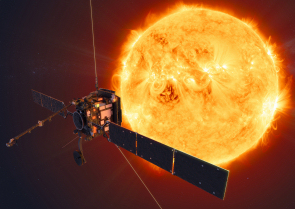
![]() ESA's Solar Orbiter mission lifted off on an Atlas V 411 from Cape Canaveral, Florida, at 05:03 CET on 10 February 2020 on its mission to study the Sun from new perspectives. About 90 minutes later, mission controllers at the European Space Operations Centre in Darmstadt, Germany, received a signal from the spacecraft indicating that its solar panels had successfully deployed. (February 2020)
ESA's Solar Orbiter mission lifted off on an Atlas V 411 from Cape Canaveral, Florida, at 05:03 CET on 10 February 2020 on its mission to study the Sun from new perspectives. About 90 minutes later, mission controllers at the European Space Operations Centre in Darmstadt, Germany, received a signal from the spacecraft indicating that its solar panels had successfully deployed. (February 2020)
![]() BepiColombo was launched on 20 October 2018 from Europe's spaceport at Kourou, French Guiana on an Ariane 5. The spacecraft will have a seven-year interplanetary cruise to Mercury using solar-electric propulsion (ion thrusters) and gravity assists from Earth, Venus and eventual gravity capture at Mercury. Now the Launch and Early Orbit Phase (LEOP) has been started and it will end on the fourth day after launch. Then the commissioning activities will be completed. The commissioning of the spacecraft (MPO and MTM) includes deployment of the medium- and high-gain antennas and the magnetometer boom, release of the electric propulsion system thruster-pointing mechanisms, MPO payload and MMO activation and functional checkout, as far as this is possible in the MCS configuration. (October 2018)
BepiColombo was launched on 20 October 2018 from Europe's spaceport at Kourou, French Guiana on an Ariane 5. The spacecraft will have a seven-year interplanetary cruise to Mercury using solar-electric propulsion (ion thrusters) and gravity assists from Earth, Venus and eventual gravity capture at Mercury. Now the Launch and Early Orbit Phase (LEOP) has been started and it will end on the fourth day after launch. Then the commissioning activities will be completed. The commissioning of the spacecraft (MPO and MTM) includes deployment of the medium- and high-gain antennas and the magnetometer boom, release of the electric propulsion system thruster-pointing mechanisms, MPO payload and MMO activation and functional checkout, as far as this is possible in the MCS configuration. (October 2018)
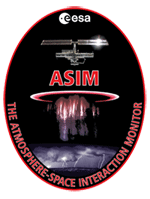
![]() The ASIM observatory has been successfully launched by a SpaceX Falcon 9 rocket from Cape Canaveral for the ISS on 2 April 2018. It will observe gigantic lightning and Gamma-ray flashes powered by thunderstorms. The MXGS instrument carries two set of detectors for TGF. The low energy detector senstive in the spectrcal band from 15 keV to 400 keV and the high energy detector sensitive from 200 keV to 40 MeV. The low energy detector is pixellated in 128 by 128 channels, which, in combination with a high mass density coded mask in front of the detector, allows advanced post-processing algorithms to pin point the direction to the TGF source. Creotech Instruments S.A., as a subcontractor of Centrum Badań Kosmicznych PAN, was responsible for assembling the final (qualified and flight) models of Polish instrument, which included more than 30 blocks of electronics that meets the strong requirements to work in space. (April 2018)
The ASIM observatory has been successfully launched by a SpaceX Falcon 9 rocket from Cape Canaveral for the ISS on 2 April 2018. It will observe gigantic lightning and Gamma-ray flashes powered by thunderstorms. The MXGS instrument carries two set of detectors for TGF. The low energy detector senstive in the spectrcal band from 15 keV to 400 keV and the high energy detector sensitive from 200 keV to 40 MeV. The low energy detector is pixellated in 128 by 128 channels, which, in combination with a high mass density coded mask in front of the detector, allows advanced post-processing algorithms to pin point the direction to the TGF source. Creotech Instruments S.A., as a subcontractor of Centrum Badań Kosmicznych PAN, was responsible for assembling the final (qualified and flight) models of Polish instrument, which included more than 30 blocks of electronics that meets the strong requirements to work in space. (April 2018)
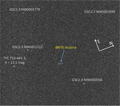
![]() Brite-Austria has been observed on the images from the PST2 telecscope located in Winer Observatory in Arizona. The animation shows a sequence of 20 images of a small field in Orion. BRITE-Austria passes the field in images from 8th to 12th. The images were captured with the Andor iXon X3 EMCCD camera attached to the PST2 70-cm telescope, the exposure time was only 0.02s. Animation courtesy Krzysztof Kamiński from Poznań Observatory. (May 2017)
Brite-Austria has been observed on the images from the PST2 telecscope located in Winer Observatory in Arizona. The animation shows a sequence of 20 images of a small field in Orion. BRITE-Austria passes the field in images from 8th to 12th. The images were captured with the Andor iXon X3 EMCCD camera attached to the PST2 70-cm telescope, the exposure time was only 0.02s. Animation courtesy Krzysztof Kamiński from Poznań Observatory. (May 2017)
![]() In late 2016/early 2017 several new publications related to BRITE have
appeared. H. Pablo et al. The BRITE Constellation Nanosatellite Mission: Testing, Commissioning, and Operations describe the testing, commissioning and operations of the BRITE satellites. In particular, they show how unexpected technical problems related to high-energy cosmic radiation were mitigated. (March 2017)
In late 2016/early 2017 several new publications related to BRITE have
appeared. H. Pablo et al. The BRITE Constellation Nanosatellite Mission: Testing, Commissioning, and Operations describe the testing, commissioning and operations of the BRITE satellites. In particular, they show how unexpected technical problems related to high-energy cosmic radiation were mitigated. (March 2017)
![]() ExoMars was launched on a Russian Proton rocket from Baikonur on 14 March 2016, it has arrived at Mars in the last quarter of 2016. The Trace Gas Orbiter has reached successfully the Martian orbit in October 2016. In November the elliptical orbit of TGO/ExoMars takes from 230-310 km above the surface to around 98 000 km every 4.2 days. The science operations phase of instruments is expected to begin at the earliest in May of 2017 (depending on the actual duration of the aerobraking phase) and last for a period of one Martian year. The science instruments on-board will determine the presence, quantity and potential sources and sinks of atmospheric methane, its precursor and product trace gases in the Martian atmosphere. (November 2016)
ExoMars was launched on a Russian Proton rocket from Baikonur on 14 March 2016, it has arrived at Mars in the last quarter of 2016. The Trace Gas Orbiter has reached successfully the Martian orbit in October 2016. In November the elliptical orbit of TGO/ExoMars takes from 230-310 km above the surface to around 98 000 km every 4.2 days. The science operations phase of instruments is expected to begin at the earliest in May of 2017 (depending on the actual duration of the aerobraking phase) and last for a period of one Martian year. The science instruments on-board will determine the presence, quantity and potential sources and sinks of atmospheric methane, its precursor and product trace gases in the Martian atmosphere. (November 2016)
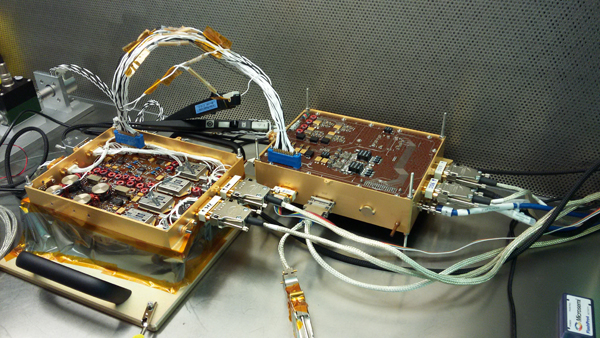
![]() In 2015 in CBK the flight model of power converter module was finished for CaSSIS instrument for Mars orbiter TGO (Trace Gas Orbiter) for ExoMars mission. In August the module was delivered to Switzerland and then it was integrated with the other flight boards into the complete electronic box. The full integration of CaSSIS instrument and tests were perfored during autumn. In the end of December CaSSIS was delivered to Baikonur to be integrated with TGO system and mounted on the spacecraft. The launch of ExoMars is planned for March 2016 and then it will arrive at Mars in the last quarter of 2016. (December 2015)
In 2015 in CBK the flight model of power converter module was finished for CaSSIS instrument for Mars orbiter TGO (Trace Gas Orbiter) for ExoMars mission. In August the module was delivered to Switzerland and then it was integrated with the other flight boards into the complete electronic box. The full integration of CaSSIS instrument and tests were perfored during autumn. In the end of December CaSSIS was delivered to Baikonur to be integrated with TGO system and mounted on the spacecraft. The launch of ExoMars is planned for March 2016 and then it will arrive at Mars in the last quarter of 2016. (December 2015)
![]() The contract for the construction of the CCB and FWA system of ASPIICS for PROBA-3 coronograph was signed on July 8, 2015 between the Centrum Badań Kosmicznych, representing the Polish site of subcontractors, and the Centre Spatial de Liege - Université de Liege. CBK will deal, in particular, with the system engineering project, development of the on-board computer, ensuring appropriate product assurance, then the design and implementation of the driver housing and internal wiring. CBK is also responsible for the integration of the CCB (in our clean-room) and for the functional tests. (July 2015)
The contract for the construction of the CCB and FWA system of ASPIICS for PROBA-3 coronograph was signed on July 8, 2015 between the Centrum Badań Kosmicznych, representing the Polish site of subcontractors, and the Centre Spatial de Liege - Université de Liege. CBK will deal, in particular, with the system engineering project, development of the on-board computer, ensuring appropriate product assurance, then the design and implementation of the driver housing and internal wiring. CBK is also responsible for the integration of the CCB (in our clean-room) and for the functional tests. (July 2015)

![]() Happy Birthday for Lem! On 21 November 2014, the first Polish scientific satellite BRITE-PL "Lem" celebrated its first year of operation in orbit. Within this year the spacecraft has completed 5270 orbits around the Earth and has travelled over 230 million kilometers since its launch. "Lem" operates as planned and performs a regular research and observations according to the BRITE mission plan. The photo on the left presents the part of sky with Orion constellation captured by the satellite's telescope, the Pleiades star cluster is shown on the part of the enlarged image. (November 2014)
Happy Birthday for Lem! On 21 November 2014, the first Polish scientific satellite BRITE-PL "Lem" celebrated its first year of operation in orbit. Within this year the spacecraft has completed 5270 orbits around the Earth and has travelled over 230 million kilometers since its launch. "Lem" operates as planned and performs a regular research and observations according to the BRITE mission plan. The photo on the left presents the part of sky with Orion constellation captured by the satellite's telescope, the Pleiades star cluster is shown on the part of the enlarged image. (November 2014)
![]() On 19 August 2014 the second Polish scientific satellite BRITE-PL "Heweliusz" was launched at 3:15:00 UTC (at 5:15:00 CET) by a Chinese Long March-4B rocket from the launch complex of Taiyuan Satellite Launch Center, 600 km on south-west from Beijing.
On 19 August 2014 the second Polish scientific satellite BRITE-PL "Heweliusz" was launched at 3:15:00 UTC (at 5:15:00 CET) by a Chinese Long March-4B rocket from the launch complex of Taiyuan Satellite Launch Center, 600 km on south-west from Beijing.
The first connection to "Heweliusz" was established at 10:02 am during the first pass of the satellite over Europe. The first signal from "Heweliusz" was received, which was quite strong and stable. Communication in both directions (up and downlink) was fine, practically without any downtime and delays. The House Keeping onboard computer (HKC) was switched on and housekeeping data was received. All the main operating parameters are OK. (August 2014)
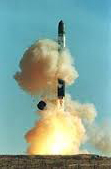
![]() On 21 November 2013 at 7:10:11 UTC time (8:10:11 CEST -Central European time CET) Russian Dnepr rocket RS-20 reached low Earth orbit with the First Polish Scientific Satellite BRITE-PL "Lem". Dnepr rocket was launched from an underground silo in Yasny military base in the Southern Urals.
On 21 November 2013 at 7:10:11 UTC time (8:10:11 CEST -Central European time CET) Russian Dnepr rocket RS-20 reached low Earth orbit with the First Polish Scientific Satellite BRITE-PL "Lem". Dnepr rocket was launched from an underground silo in Yasny military base in the Southern Urals.
One hour and 38 minutes after the launch of the Dnepr rocket, during the first pass of the satellite over Europe, the connection to "Lem" was established. Now regular communication with is taking place during morning and evening passes. The functional tests of "Lem" are performed in orbit. The satellite operates according to the plan. More info on www.brite-pl.pl. (November 2013)
![]() Brite-PL "Heweliusz" is already assembled! The satellite "Heweliusz" has been already assembled and it passes now the final part of tests before launch. In October it passed the vibration tests in DLR laboratory in Berlin. (October 2013)
Brite-PL "Heweliusz" is already assembled! The satellite "Heweliusz" has been already assembled and it passes now the final part of tests before launch. In October it passed the vibration tests in DLR laboratory in Berlin. (October 2013)
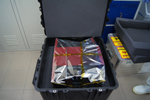
![]() The first Polish scientific satellite "Lem" on its way to cosmodrome! The First Polish Scientific Satellite "Lem" has finished its last tests in clean-room in the Centrum Badań Kosmicznych and it has started its journey to Yasny launch base in Russia leaving the CBK on 23 September 2013. In October/November the satellite was being prepared for installation on the Dniepr rocket and it passed final tests. Engineers from the CBK and SFL worked on readying "Lem for launch". (September 2013)
The first Polish scientific satellite "Lem" on its way to cosmodrome! The First Polish Scientific Satellite "Lem" has finished its last tests in clean-room in the Centrum Badań Kosmicznych and it has started its journey to Yasny launch base in Russia leaving the CBK on 23 September 2013. In October/November the satellite was being prepared for installation on the Dniepr rocket and it passed final tests. Engineers from the CBK and SFL worked on readying "Lem for launch". (September 2013)
![]() Dr Marcin Stolarski won the Polish edition of the Famelab 2013! Congratulations to our colleague! (July 2013)
Dr Marcin Stolarski won the Polish edition of the Famelab 2013! Congratulations to our colleague! (July 2013)
![]() HERSCHEL ends operations as orbiting laboratory! Science observing performed with the instruments of Herschel spacecraft was continued until end-of-helium which took place on 29 April 2013. But the stalwart satellite continued providing value to the end, serving as an orbiting testbed for control techniques that can't normally be tested in flight. At last mission controllers in ESOC sent the final command to the Herschel satellite on 17 June 2013 at 12:25 GMT (14:25 CEST), marking the end of operations for ESA's hugely successful space observatory. Earlier it was ensured that all fuel is depleted and the satellite was boosted away from its operational orbit around the L2 Sun-Earth Lagrange Point into a safe heliocentric orbit. (June 2013)
HERSCHEL ends operations as orbiting laboratory! Science observing performed with the instruments of Herschel spacecraft was continued until end-of-helium which took place on 29 April 2013. But the stalwart satellite continued providing value to the end, serving as an orbiting testbed for control techniques that can't normally be tested in flight. At last mission controllers in ESOC sent the final command to the Herschel satellite on 17 June 2013 at 12:25 GMT (14:25 CEST), marking the end of operations for ESA's hugely successful space observatory. Earlier it was ensured that all fuel is depleted and the satellite was boosted away from its operational orbit around the L2 Sun-Earth Lagrange Point into a safe heliocentric orbit. (June 2013)
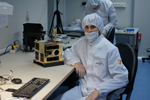
![]() The assembling of the First Polish Scientific Satellite is finished! The first satellite "Lem" is already assembled and ready for lift-off to its orbit. It is placed in the clean-room in Centrum Badań Kosmicznych, where it passes the functional tests. Soon the "open-field" tests and scietific software verification will be performed as well. (March 2013)
The assembling of the First Polish Scientific Satellite is finished! The first satellite "Lem" is already assembled and ready for lift-off to its orbit. It is placed in the clean-room in Centrum Badań Kosmicznych, where it passes the functional tests. Soon the "open-field" tests and scietific software verification will be performed as well. (March 2013)

![]() In 2012 the new Laboratory of Final Functional Tests of Space Instruments was organized and equipped. This was done thanks to the co-financing from the European Union from the European Regional Development Fund under the Regional Operational Programme for Mazovian Voivodship 2007 - 2013, Priority I - "Creating conditions for development of innovation potential and entrepreneurship in Mazovia", Action 1.1 Consolidation of the research & development (R&D) sector. (December 2012)
In 2012 the new Laboratory of Final Functional Tests of Space Instruments was organized and equipped. This was done thanks to the co-financing from the European Union from the European Regional Development Fund under the Regional Operational Programme for Mazovian Voivodship 2007 - 2013, Priority I - "Creating conditions for development of innovation potential and entrepreneurship in Mazovia", Action 1.1 Consolidation of the research & development (R&D) sector. (December 2012)